Another important consideration when transitioning to battery electric buses is vehicle range. The range is influenced by a number of factors which include:
Manufacturers advise on ranges using the unit ‘kWh per km’ that is supposed to indicate shows how well the bus uses the energy. Quoted ranges for battery electric buses vary greatly depending on manufacturer specifications. A range of approximately 300km is relatively common. Long range battery electric buses tend to have more batteries with the trade-off being higher capital cost and increased vehicle weight, which may mean a lower legal passenger carrying capacity.
Be aware and cautious of the different ways in which battery electric bus range is measured when procuring fleet. Some bus manufacturers quote a guaranteed range (worst case scenarios) at the end of the battery life whilst others quote best case or average range at the start of the battery life. Some quoted ranges assume the buses are fully laden and using heating, ventilation, or air conditioning (HVAC) while other manufacturers do not take as conservative an approach. A more direct comparison is to compare the capacity of the battery, which is measured in kilowatt hours, qualified with the expected life cycle of the battery.
Instead of relying on manufacturer specifications public transport contracting authorities and bus operators should request range analysis that uses information about the actual services which the battery electric buses will be used to deliver. This analysis can be used to test a number of different scenarios such as high HVAC use during times of temperature extremes and near end-of-life operation when the range of the battery electric buses is expected to be reduced.
Irrespective of whether operated by battery electric or diesel buses, the distance that a bus may need to travel on any given day is determined by several factors which can include the following:
A bus used for a split shift (with a break during the middle of the day) could travel approximately 30km to 60km before returning to the depot, at which point it could be charged briefly before the afternoon proportion of the shift. A bus used for an all-day shift could be on the road for approximately 150km to 350km before returning to the depot for charging overnight.
Based on the typical range quoted by manufacturers, start of life battery electric buses should comfortably be able to complete split shifts and be charged at the depot either between shifts or at end of day. However, as the battery degrades over time adjustments to driver schedules or bus assignment may be necessary to manage the range of mid-life battery electric buses.
Long range battery electric buses could complete all-day shifts on a single charge, however in some situations, opportunity charging may be required to extend the time on road before returning to the depot. Alternatively, bus operators could shorten drivers’ shifts where these exceed the range of battery electric buses (however this could increase operating costs due to increased dead running back to depot).
In situations where bus operators have battery electric bus fleets which include buses with degraded batteries there could be the need to assign individual buses to schedules. This is because a start of life bus could complete a long shift but a mid-life bus with a shorter range might not be able to complete the same shift. Therefore, bus operators should regularly monitor the battery state of charge and manage the fleet and driver schedules according to the expected range. For diesel bus operations it is uncommon for buses to be assigned to specific driver shifts and therefore the management of battery electric bus fleets would represent a change in practice for bus operators.
The amount of energy left in a battery pack is referred to as the state of charge (SOC). It is equivalent to the fuel gauge on a traditional vehicle, telling the driver how much energy remains. While SOC can theoretically be between 0% and 100% full, in practice the SOC has minimum and maximum limits in place to protect the long-term useful life of the battery. The minimum allowable SOC is set above 0% to minimise battery performance degradation. An additional lower level of the SOC, “reserved energy”, is set aside as a contingency during emergencies and unforeseen delays. This reserve varies from 10% to 35% between battery manufacturers. When fast charging near the upper SOC limit (typically the upper 10%–25%), you may find the allowable charge rates tapers quickly as well. After all limits are applied, the usable energy is roughly 70% of theoretical battery capacity at its beginning of life.
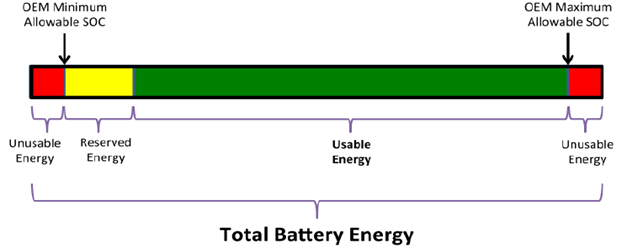
Beginning of life battery. (Image source: Bigelow 2017)
Battery capacity diminishes over time and usage. As batteries charge and discharge, their internal physical and chemical structures degrade. As a new and rapidly evolving technology, batteries for electric buses are subject to lifetime uncertainty, though some major manufacturers offer 12-year warranties on their batteries. The end of battery life typically occurs when a battery has less than 80% of its initial capacity, although this threshold can be pushed as low as 60%. The figure below shows the SOC limits for a battery near the end of its life. While the minimum allowable SOC is highly similar to a new battery, the upper charge limit is significantly lower than a new battery.
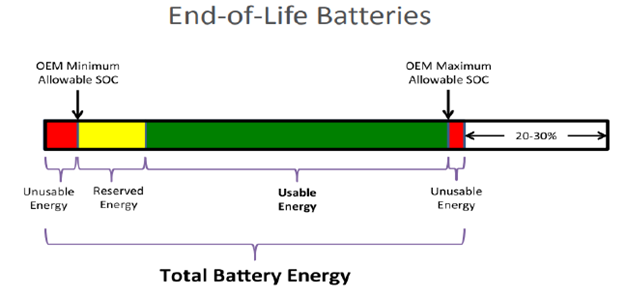
End of life battery. (Image source: Erik Bigelow 2017)
The rate at which bus batteries degrade depends on several factors including:
The chemistry and structure of batteries determines the characteristics of the battery including specific energy, specific power, self-heating rate and lifespan.
Specific energy is the amount of energy that a battery can store per kilogram whereas specific power is the rate at which a battery can deliver power. Battery technology is constantly changing but the typical characteristics of different types of batteries are shown in the diagrams below. Generally speaking, nickel manganese cobalt batteries have good overall performance with excellent specific energy, lithium iron phosphate batteries have enhanced safety and lithium titanate oxide batteries enable fast charging but low specific energy.
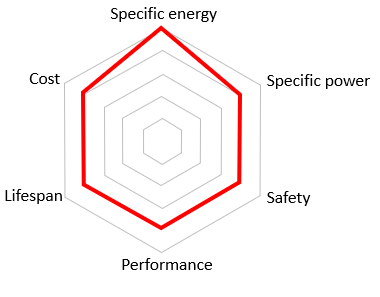
Nickel manganese cobalt (MCA).

Lithium iron phosphate (LFP).
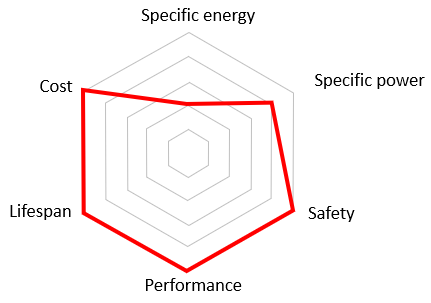
Lithium titanate oxide (LTO).
Another factor which influences the rate at which batteries degrade is the charging method used. Fast chargers can degrade batteries quicker than slow charging due to the higher heat which results from the rapid transfer of electricity. Mitigation strategies which can reduce this impact include:
Maintaining an optimal SoC range can also help to extend battery service life with the optimal range generally being between 20% to 80% SoC. This is because a partial charge and discharge cycle places less stress on the battery than a full cycle. In practice this could mean charging the bus as much as is needed for the following shift allowing for some contingency instead of charging all buses to 100%.
In 2019, three two axle battery electric buses were introduced on Christchurch’s Route 29 between the central bus interchange and Christchurch Airport. They were a direct replacement for three diesel buses which operate on a route of just over 11km along flat terrain. The battery electric buses were contractually required to be able to travel 300km over a 16.5 hour operating period on a single overnight charge. They also had to have suitable luggage provision for an airport service while maximising seated capacity. The buses procured for this service are quoted to easily achieve the range required of them and have capacity for 55 passengers (36 seated). They are recharged simultaneously overnight at the depot with no need for opportunity charging.
The combined weight of the batteries, customers and their luggage on a two-axle vehicle required an over-weight permit to be issued by Waka Kotahi. This limits the use of the electric buses to the permitted route, but given it is an airport specific service, this has not constrained the operator. The operator has subsequently sought approval for the use of these three buses on another contracted services, which creates vehicle allocation flexibility should the need arise.
Vehicle weights and the possibility of requiring approvals should occur in any planning or procurement discussions.
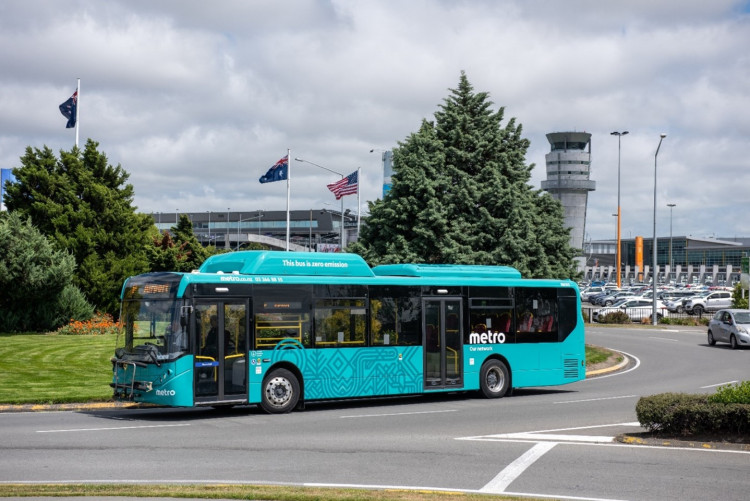
Christchurch battery electric bus. (source: Environment Canterbury)